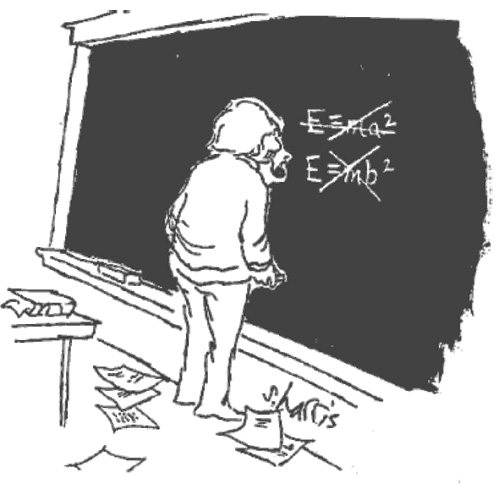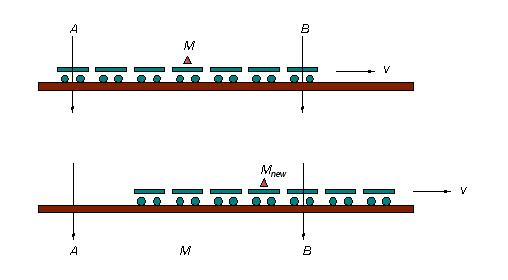|

Credit: Sidney Harris
Perceiving Einstein
Oct
19, 2010
To the average person the words
“Einstein” and “Relativity” are
reflexively synonymous with
“complexity,” “unintelligibility,”
and the notion that “this has to
involve obscure mathematics.”
We all know that Albert Einstein
invented Special Relativity (SR) and
its extension, General Relativity (GR).
But what are they? Are these
theories correct? Are they useful?
Does it take a physicist or
mathematician to understand them?
Typically, any search of your local
library or the Internet for a clear
explanation of what Relativity
Theory is all about usually falls
quickly into a tangle of concepts
such as Minkowsky space, time
dilation, and other hypotheses – all
impenetrable for the uninitiated. Or
at least they have been up to now.
For years I have sought a simple
explanation of these ideas. That
search has been discouragingly
unproductive. Early on I became
aware that both SR and GR are
controversial. Opinions on both
sides of the question of their
validity are intense. On one side,
cosmologists and astrophysicists
accept, defend, and use Einstein’s
ideas to further their own work.
They claim absolute success for
models that result from their use of
his theories. They disparage anyone
who deigns to question the soundness
of their beliefs.
Several non-believers1, 2
claim to have identified chinks in
the body armor of Einstein’s work
and in the validity and precision of
later experiments that allegedly
support it. But, understanding the
thrusts and counter-thrusts of these
arguments requires proficiency in
graduate-level math through tensor
analysis. Therefore, until recently,
even the well-educated, interested
reader has been unable to really
understand this and thus has had no
chance to develop an informed
opinion. This all changed for me
when I read a book written by
astronomer Hilton Ratcliffe.
Hilton Ratcliffe
In the eleventh chapter of his
first book3
Ratcliffe presents an account of
some of the fundamental issues,
assumptions, and goals that prompted
Einstein’s work. He does this using
only words – without mathematics4.
For me these pages provided an
opening key to the arcane concepts
that had eluded me for so long.
Ratcliffe starts by pointing out
that one of Einstein’s primary
assumptions or goals (it is not
clear which) was to show the
impossibility of the existence of
absolute universal time and the real
simultaneity of events.
One of the necessary tools for
evaluating Einstein’s argument is
the concept of the “reference frame”
and what happens when two such
frames move relatively to
each other.
Frames of reference
Take three one-meter rulers.
Arrange two of them, lying on your
desk, at right angles to each other.
Now set the third ruler vertically
at the junction of the first two and
secure them all to each other so the
(90°) angles between them are fixed.
Name the two horizontal rulers x
and y. Call the vertical
ruler z. The instantaneous
position of any object (a fly, a
dust mote, etc.) can be uniquely
defined by measuring its distance
out along each of the rulers e.g.,
x = 3 cm, y = 4 cm,
and z = 8 cm. This defines
the position of the object. The set
of rulers thus provides a “frame of
reference” in which the location of
any point can be described. Any
change in this position measures the
“motion” of the object in this frame
of reference. Of course the rulers
must be straight and the gradation
marks along them must be equally
spaced and not move with respect to
one another.

Figure 1. Einstein’s example of
two simultaneous lightning strokes
down to points A and B.
Another frame of reference (set
of rulers) can be constructed and
placed on a rotating merry-go-round.
The position of any object (say for
example an insect sitting still on
the merry-go-round) can be measured
by both of these frames of
reference. In one of them (the one
on the merry-go-round) the insect’s
velocity is zero. The other frame of
reference would describe the insect
as moving in a circle. When one
frame of reference is moving with
respect to another frame of
reference, different measurements of
motion will be recorded by the same
event.
Coriolis effect
An example of this is the
so-called Coriolis effect.
Suppose we have a stationary
circular merry-go-round on which two
people stand facing each other at
the ends of a diameter of the disk.
One throws a ball directly toward
the other person who catches it.
Both our frames of reference (one
attached to the ground and one
sitting on the merry-go-round) would
report that the ball had traveled in
a straight line when viewed from
above.
Now rotate the merry-go-round in
a counter-clockwise direction
(looking down at it from above) at a
constant angular velocity. We can
see the path of the ball by placing
a downward looking TV camera above
the merry-go-round. But if the
camera is fixed to the stationary
Earth, we will see that although the
ball initially moves directly toward
the other person, he will be rotated
away from his initial location and
not be there to catch it when the
ball arrives. Because the ball
still travels in a straight line.
If we mount another downward
looking camera – this one fixed to
the rotating merry-go-round – the
two people will appear to be
stationary and the ball will appear
to curve off to the right. This
effect is demonstrated on several
Youtube presentations.5 It is
important to realize that the
perception the observer gets
about what is occurring depends on
which frame of reference he is in.
Relativity example
Ratcliffe describes an experiment
proposed by Einstein that involves
an observer riding on a railroad
train. Two simultaneous lightning
strokes occur – one from the sky
down to point A on the ground
and the other down to point B.
At that instant the train happens to
be located such that its front end
is passing over point A and
its back end over point B.
The situation is shown in the top
diagram in figure 1 above.
The train is moving with constant
velocity v toward the right.
Assuming light propagates with a
finite velocity, the observer at
point M is unaware of the
flashes until a time, T, has
passed. But the train has moved
toward the right during that time
interval. The lower diagram shows
the position of the train after
time, T, has passed. The
observer, now at position Mnew,
sees the flash from stroke B.
But because the light from A
has farther to travel, he still is
unaware of it.
Therefore, the observer perceives
that stroke B has occurred
prior to stroke A. The reason
for this is, of course, that the
observer’s frame of reference is
moving relative to the stationary
“inertial” frame – the Earth.
Einstein then goes on to conclude
that, in the frame of the observer,
which is moving toward the right,
the two events were really
not simultaneous.
Can you see the error? If he had
said that the observer’s
perception of what happened was
that stroke B occurred first,
he would have been correct. But his
interpretation was that, within the
moving frame of the observer the two
events were in reality not
simultaneous.
Einstein confused the observer’s
perception of reality with
reality itself.
Another even more confusing and
erroneous interpretation of what
actually happened in this experiment
is that time, as measured by a
stopwatch held by the observer,
slowed down. This is because the
interval between stroke B and
its observation at Mnew
is too short. The moving
stopwatch measured too few
nanoseconds – so Einstein said,
“Clocks in a moving frame of
reference slow down.” Of course,
this is nonsense.
Ratcliff easily falsifies the
hypothesis that a moving clock slows
down via the following example.
Consider two clocks, A and
B, moving toward each other
along a straight line joining them.
Relativists consider that a clock
that is moving within any frame of
reference with respect to one that
is fixed to that frame, runs slow.
Referred to A, B goes
slow. Referred to B, A
goes slow. But they cannot each go
slower than the other one. So the
idea is mutually contradictory.
To quote Ratcliffe, “The mistake
[Einstein] makes, one he commits
consistently throughout development
of Special Relativity Theory, is
that he confuses his frames of
reference and does not adjust for
varying travel times of
constant-velocity signals covering
different distances.”
I would add that, more
importantly, Einstein mistakenly
glosses over the distinction between
an observer’s perception of
reality and reality itself.
Reality exists. Reality will
continue to exist even after you and
I both die and are unable to
perceive it.
If Einstein had observed the
Coriolis experiment that involved
throwing a ball across a rotating
merry-go-round, he would have
falsely concluded that the ball
really did curve in the
“reality” of the rotating frame of
reference. That is what the observer
perceived. But that’s not what
happened. “Seeing is believing” is
sometimes “seeing is misleading”. An
observer’s perceptions must
not be improperly upheld as being of
equal validity with reality.
Perceptions are often inaccurate.
“My reality is just as valid as
your reality” is not universally
true.
Conclusion
Ratcliffe’s The Virtue of
Heresy provides a sound,
accessible critique of fundamental
logical errors in SR and GR that
have been unnoticed in the past,
even by people with outstanding
physics and mathematical
backgrounds. He attacks the basic
foundations of Einstinian theory
with clarity, counter-examples, and
sharp dissection of some of the
imprecise “gedanken-experimental
results” and “observations” that are
thrown up in support of these
notions.
This book is a powerful resource.
When taken together with Steve
Crothers’ devastating analyses of
errors in the tensor analyses that
have here-to-fore been effectively
raised as an impenetrable barrier to
any criticism of SR and GR normally
intelligent people need no longer
feel intimidated.
We must remember that the
erroneous Ptolemaic Earth-centered
universe model lasted for at least a
thousand years. But that was before
enquiring minds had access to books
and the Internet. Possibly we will
now not have to wait that long for
the false SR and GR theories to be
put to rest.
Contributed by D. E. Scott
1 Stephen Crothers
-
http://www.sjcrothers.plasmaresources.com/index.html
2 Sid
Deutsch – Einstein’s Greatest
Mistake, iUniverse, 2006.
3 Hilton Ratcliffe – The Virtue
of Heresy,
http://www.booksurge.com,
2008.
4 Even though
on page 286 he chastises electrical
theorists by saying, “Give us the
numbers! Do your sums and tell us
the formulae that apply to
systematic study of the cosmos.”
5
http://www.youtube.com/watch?v=mcPs_OdQOYU&feature=related
|








